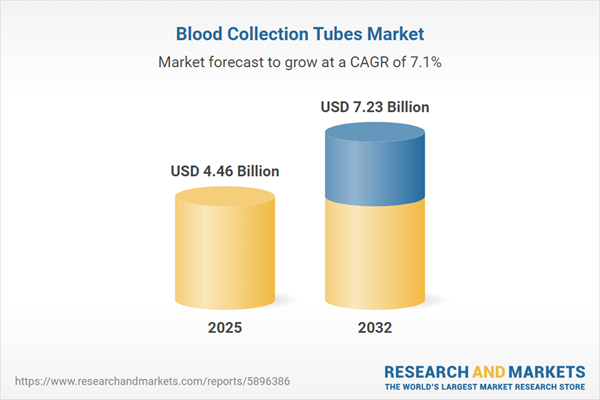Speak directly to the analyst to clarify any post sales queries you may have.
The Blood Collection Tubes Market is evolving swiftly to address the increasing complexity of diagnostic demands and supply chain expectations within modern healthcare ecosystems. As clinicians and laboratories pursue operational efficiency and accuracy, industry stakeholders are prioritizing solutions that integrate workflow innovation with compliance and safety.
Market Snapshot
The blood collection tubes market grew from USD 4.18 billion in 2024 to USD 4.46 billion in 2025 and is projected to continue expanding at a CAGR of 7.08%, reaching USD 7.23 billion by 2032. This growth is propelled by rising global diagnostic volumes, increasing adoption of personalized medicine, and stringent regulatory oversight shaping procurement criteria. Demand is rising for advanced additive formulations, traceability features, and robust performance in both conventional and emerging clinical settings, driving strategic investments among manufacturers and procurement teams alike.
Scope & Segmentation
- Tube Types: Citrate Tubes, EDTA Tubes, Glucose Tubes, Heparin Tubes, Plasma Separation Tubes (PST), Serum Separation Tubes (SST)
- Material Types: Glass Tubes, Plastic Tubes
- Application Areas: Blood Banking, Clinical Diagnostics, Forensic, Molecular Diagnostics, Research & Development
- End Users: Blood Banks, Diagnostic Laboratories, Home Care Settings, Hospitals, Research Institutions
- Regional Coverage: Americas (United States, Canada, Mexico, Brazil, Argentina, Chile, Colombia, Peru), Europe (United Kingdom, Germany, France, Russia, Italy, Spain, Netherlands, Sweden, Poland, Switzerland), Middle East (United Arab Emirates, Saudi Arabia, Qatar, Turkey, Israel), Africa (South Africa, Nigeria, Egypt, Kenya), Asia-Pacific (China, India, Japan, Australia, South Korea, Indonesia, Thailand, Malaysia, Singapore, Taiwan)
- Leading Companies: Abbott Laboratories, AdvaCare Pharma, Becton Dickinson & Company, Biosigma S.p.A., Bio-Rad Laboratories, Cardinal Health, CML BIOTECH LIMITED, Convergent Technologies GmbH, Corning Incorporated, FL Medical S.R.L., Greiner Bio One International Gmbh, Haemonetics Corporation, Labtech S.r.l., Medline Industries, Medtronic plc, Merck KGaA, Micsafe Medical Group, Nanjing Vazyme Medical Technology, Nipro Medical Corporation, QIAGEN N.V., Radiometer Medical ApS, SARSTEDT AG & Co. KG, Simport, Terumo Corporation, Thermo Fisher Scientific
Key Takeaways
- Rising demand for workflow optimization and turnaround speed in laboratories is driving innovations such as automated cap pierce systems and compatibility with point-of-care technology.
- Material science is advancing with lightweight yet rigid plastic tubes and glass tubes offering enhanced chemical resistance, allowing buyers to better balance safety and environmental impact.
- Segment differentiation, such as tube type and application area, shapes inventory management, customization needs, and laboratory procurement priorities in clinical and research settings.
- End user requirements diverge, with blood banks focusing on throughput, diagnostic labs seeking automation compatibility, and home care prioritizing leak-proof and user-friendly formats.
- Manufacturers are increasingly leveraging vertical integration, digital traceability, and regional distribution centers to reduce risk and ensure reliable, compliant access worldwide.
Tariff Impact: Navigating United States Measures and Supply Chain Resilience
Recent United States tariff measures have prompted many suppliers to reassess sourcing strategies, adapt production footprints, and secure long-term contracts to stabilize costs and mitigate delays. This has led to diversified vendor networks, flexible procurement terms, and increased collaboration with domestic manufacturers, ensuring continued access to compliant products despite continued global trade uncertainty.
Methodology & Data Sources
This analysis is built upon interviews with industry experts, triangulated through regulatory filings, supplier catalogs, and market reports. Rigorous validation methods, including scenario modeling and SWOT analysis, were employed to ensure reliability and strategic relevance.
Why This Report Matters
- Equips industry leaders with actionable insights to inform R&D investment, technology selection, and procurement strategy in a rapidly changing landscape.
- Clarifies the interplay between regulatory changes, technological advancement, and regional market dynamics essential for informed strategic planning.
- Provides an in-depth segmentation and competitive analysis to support investor decisions, innovation strategies, and risk assessment initiatives.
Conclusion
The blood collection tubes market is being reshaped by shifting healthcare priorities, technology advances, and complex global supply chains. Organizations that prioritize innovation, supply chain agility, and regional adaptation will be positioned to deliver robust, compliant solutions that meet evolving diagnostic and operational needs.
Additional Product Information:
- Purchase of this report includes 1 year online access with quarterly updates.
- This report can be updated on request. Please contact our Customer Experience team using the Ask a Question widget on our website.
Table of Contents
3. Executive Summary
4. Market Overview
7. Cumulative Impact of Artificial Intelligence 2025
Companies Mentioned
The companies profiled in this Blood Collection Tubes market report include:- Abbott Laboratories
- AdvaCare Pharma
- Becton, Dickinson & Company
- Biosigma S.p.A.
- Bio-Rad Laboratories, Inc.
- Cardinal Health, Inc.
- CML BIOTECH LIMITED
- Convergent Technologies GmbH
- Corning Incorporated
- FL Medical S.R.L.
- Greiner Bio One International Gmbh
- Haemonetics Corporation
- Labtech S.r.l.
- Medline Industries, Inc.
- Medtronic plc
- Merck KGaA.
- Micsafe Medical Group
- Nanjing Vazyme Medical Technology Co., Ltd.
- Nipro Medical Corporation
- QIAGEN N.V.
- Radiometer Medical ApS
- SARSTEDT AG & Co. KG
- Simport, Inc.
- Terumo Corporation
- Thermo Fisher Scientific
Table Information
| Report Attribute | Details |
|---|---|
| No. of Pages | 185 |
| Published | November 2025 |
| Forecast Period | 2025 - 2032 |
| Estimated Market Value ( USD | $ 4.46 Billion |
| Forecasted Market Value ( USD | $ 7.23 Billion |
| Compound Annual Growth Rate | 7.0% |
| Regions Covered | Global |
| No. of Companies Mentioned | 26 |









